2010 Pinots Tasted in the Willamette
Shea Wine Cellars: The Whole Pinot Shea-bang
Dick Shea farms 136.5 acres of Pinot Noir and 3.5 acres of Chardonnay in the Yamhill-Carlton District. Grapes
are sold to 22 other notable producers of Pinot Noir in the Willamette Valley ( Antica Terra, Beaux Frères,
Bergström, Boedecker, Elk Cove, J.K. Carrier, Ken Wright Cellars, Panther Creek Cellars, Penner-Ash, Raptor
Ridge, Rex Hill, Stephen Goff, Stevenson Barrie Cellars, St. Innocent, Wildair, and Winderlea) and California
(Ancien, Auteur, Roessler, and Sonoria). 25% of the vineyard production is held back for Shea’s own Shea
Wine Cellars label (about 5,500 cases).
Pinot Noir clones planted at Shea Vineyard include Pommard, Wädenswil, and Dijon 114, 115, 777. Soils are
Willakenzie, well-drained and shallow over fractured siltstone at 450 feet elevation.
The most recent winemaker for Shea Wine Cellars, Drew Voit, left in 2012 to pursue his own label and other
projects. He was replaced by Blair Trathen, a New Zealander who has crafted wine in Oregon for ten vintages,
most recently at Rex Hill. He is currently putting the finishing touches on the 2011 wines.
The wines from Shea Wine Cellars are sold primarily through a mailing list (www.sheawinecellars.com) with
limited retail distribution. The winery is not open to the public. The nomenclature of the Shea Wine Cellars
Pinot Noirs has varied through the years, but in 2010, except for the Estate and Homer, all wines are block-designated.
When I visited in July, the Estate, Block 31 and Homer had been released. I tasted these 2010
wines from bottle and 2011 wines from blending tanks briefly at the winery and was impressed. Dick was to
send me the lineup of 2010 wines to review formerly but the hot weather in Southern California has not
permitted him to ship the wines to me. When weather permits, I will receive the wines and fill in the reviews of
the wines listed.
2010 Shea Wine Cellars Shea Vineyard Estate Willamette Valley Pinot Noir 13.2% alc., 3,475 cases, $40.
All clones planted at Shea Vineyard. Aged in 47% new French oak.
2010 Shea Wine Cellars Shea Vineyard Block 7 Willamette Valley Pinot Noir 13.5% alc., 300 cases, $56.
Wädenswil clone. Aged in 64% new French oak.
2010 Shea Wine Cellars Shea Vineyard Block 23 Willamette Valley Pinot Noir 13.5% alc., 265 cases, $56.
Pommard clone. Aged in 80% new French oak.
2010 Shea Wine Cellars Shea Vineyard Block 31 Willamette Valley Pinot Noir 13.6% alc., 240 cases, $56.
67% Pommard, 33% Wädenswil. Aged in 60% new French oak.
2010 Shea Wine Cellars Shea Vineyard Block 33 Willamette Valley Pinot Noir 13.5% alc., 250 cases, $56.
Dijon 777. Aged in 60% new French oak.
2010 Shea Wine Cellars Shea Vineyard Homer Willamette Valley Pinot Noir 13.5% alc., 450 cases, $82.
56% Wädenswil, 31% Dijon 777, 13% Pommard. Aged in 81% new French oak. A blend of the best barrels in
the cellar and always the biggest, most structured wine in the lineup, needing several years to reach a peak
drinking window.
2010 Shea Wine Cellars Shea Vineyard Willamette Valley Chardonnay 13.5% alc., 700 cases, $30. Dijon
95, 76. 100% MLF. Aged in 18% new French oak and 6% stainless drums.
Lenné Estate: Nose for Pinot
Located a few miles west of Shea Vineyard on a ridge top, Lenné (“Lenay”) Estate is farmed by Steve Lutz,
who also shares the winemaking duties with noted Oregon vintner, David O’Reilly. The initial vines went into
the ground in 2001, planted on low vigor sedimentary and volcanic soils. Today, the vineyard consists of 20.9
acres of Pinot Noir.
Beginning in 2007, the wines from Lenné Estate really showed promise, and in 2010, Steve hit the jackpot.
The entire lineup is really top notch. The entry-level wine, LeNez, is solid, and the Lenné Estate wines, which
represent the best barrels from the vineyard in each vintage, are all very special. The wines were previously
reviewed in the PinotFile in May 2012. New oak treatment varies between 35% and 50%. Steve believes that
the wines will be at their best 7 to 10 years from the vintage date.
The wines are sold through a mailing list, the winery’s website (www.lenneestate.com) and the tasting room at
18760 NE Laughlin Road in Yamhill (open weekends or by appointment). Besides the wines tasted, the
following are also available: 2010 LeNez Pinot Noir (more fruit forward and most approachable, $30) and 2010
Lenné Estate Kill Hill Pinot Noir (best barrels from the steepest part of the vineyard which has the poorest soil,
named as a tribute to the many vines that died in establishing this part of the vineyard originally, $55).
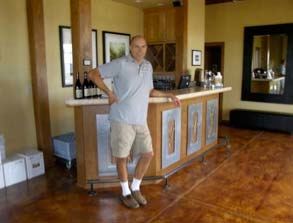
2011 Le Nez Willamette Valley Pinot Noir Blanc
13.0% alc., 30 cases. In 2011, less ripe fruit was used to produce this wine
and a rosé. Soft release (sold to wine club members and through tasting room). Aged in neutral oak, no MLF.
·
Pleasant aromas of fresh apple, tropical fruits and nuts. Bright and crisp on the palate with a good cut of
acidity on the apple-driven finish. Picks up fruit intensity over time in the glass. Good.
2010 Lenné Estate Eleanor’s 114 Yamhill-Carlton District Pinot Noir
14.0% alc., 49 cases, $55. Named
after Steve Lutz’s mother and represents the best barrels from Dijon 114 block.
·
Very expressive aromatics,
drawing the drinker into the glass. Aromas of fresh cherries, spice, leather and toast. Good depth on the
palate, with a charming elegance, offering flavors of brandied cherries, spice and sandalwood, supported by
soft tannins, ending with a pleasing lift of acidity. Very good.
2010 Lenné Estate Estate Yamhill-Carlton District Pinot Noir
14.0% alc., $45. Primarily Pommard and
Dijon 115.
·
Enticing scent of fresh strawberries and chocolate-covered cherries. Elegant and soft on the palate,
with medium weight flavors of well-spiced cherries and a hint of dark chocolate in the background. Picks up
interest and intensity over time in the glass. Very good.
2010 Lenné Estate Jill’s 115 Yamhill-Carlton District Pinot Noir
14.0% alc., 125 cases, $55. Named after
Steve Lutz’s mother-in-law. The best barrels from 115 block.
·
Shy aromas of black cherries, black raspberries,
and dark chocolate. A cherry bombast on the palate, with a subtle backing of oak. Admirable finesse, yet
enough structure to last. Gorgeous.
2010 Lenné Estate Karen’s Pommard Yamhill-Carlton District Pinot Noir
14.0% alc., 125 cases, $55. The best barrels from the vineyard’s two Pommard
blocks and is named after owner Steve Lutz’s wife, Karen.
·
The aromatics are
stunning, with high brow aromas of cherries, mocha and sandalwood. Softly
textured with supple tannins, yet offering a luscious fruit ensemble of cherries,
black raspberries and currants accented by oak spice. Great.
2008 Lenné Estate Estate Yamhill-Carlton District Pinot Noir
14.0% alc., $45. A barrel selection of the
finest barrels from the best parts of the vineyard.
·
Opens reluctantly, with shy aromas of red cherries and mint.
Intense and dense cherry core with plenty of tannic backbone and eye popping length on the dry finish. Years
away from prime time. Very good.
The Eyrie Vineyards: Sacred Ground for Pinot Noir
The Eyrie Vineyards winery and tasting room in McMinnville is a time capsule of the history of Willamette Valley
Pinot Noir. Jason Lett, who took over the legacy of this iconic winery when his father, David Lett, passed away
in October 2008, has preserved its identity and the character of David’s wines.
David Lett arrived in the Willamette Valley in 1965, established a nursery planting of Pinot Noir in Corvallis, and
in 1966, spent his honeymoon with his new spouse Diana planting the first five acres of vines that included
Pinot Noir and Pinot Gris. The Letts named their vineyard Eyrie (“Eye-ree”), an old word meaning “hawk’s
nest,” when a pair of red-tailed hawks built a nest in the fir trees above the first vineyard that the newly married
couple were planting. There are still eyries at Eyrie with hawks nesting in the trees above the vineyard each
year.
Lett produced his first Pinot Noir in 1970, but because of its light color, he labeled it “Oregon Spring Wine.” In
1979, Robert Drouhin of the famed Domaine Drouhin in Burgundy, set up a blind tasting of French burgundies
versus American Pinot Noirs. At this now famous tasting hosted by the French food and wine magazine, Gault-
Mileu, and held in Paris, a 1959 Domaine Drouhin Chambolle-Musigny came in first, but David Lett’s 1975 The
Eyrie Vineyards South Block Reserve Pinot Noir took second ahead of a number of prestigious French wines.
The Eyrie Vineyard South Block Reserve was made solely from the Wädenswil clone. This was a seminal
event for the Oregon wine industry and persuaded Robert Drouhin to establish his own vineyard and winery in
the Dundee Hills in 1987. The published results of this Gault-Mileu tasting are proudly displayed on The Eyrie
Vineyards tasting room wall:
The room where David Lett made his first wines is but the size of a small two-car garage:
David’s original oak barrels, dating to 1970, are still in use in the winery, refurbished by a local cooper as
needed:
I tasted a number of wines with Jason, some of which are quite precious, and they are dispensed through an
argon preservative system and sold to visitors by the glass. Jason has taken the time to examine all the library
Pinot Noir and Chardonnay wines, discard the oxidized or otherwise unacceptable bottles, and re-cork them.
In recent years he has organized significant retrospective tastings of The Eyrie Vineyards Pinot Noir (2008),
Chardonnay (2009, www.princeofpinot.com/article/726/) and South Block Reserve Pinot Noir (2011).
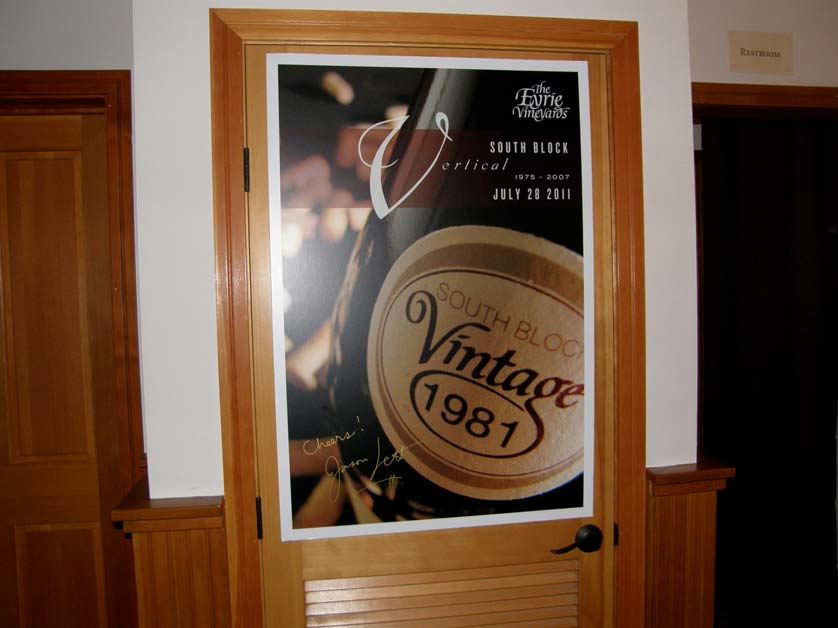
Pinot Noir estate vines at The Eyrie Vineyards, planted between 1965 and 1989, average 30 years in age, are
100% own-rooted, organically farmed, and 100% non-irrigated: unequaled in Oregon. The Eyrie Vineyard was
planted between 1966 and 1974 and consists of 17.4 acres. Wine contributions: Pinot Noir Original Vines
Reserve, Chardonnay Original Vines Reserve, Chardonnay Estate, Pinot Gris Estate, Melon de Bourgogne,
Muscat Ottonel and Pinot Meunier. The Daphne Vineyard was planted between 1974 and 1984 and consists of
12.7 acres. At almost 900 feet, Daphne is one of the oldest and highest elevation plantings in the Dundee
Hills. Wine contributions: Pinot Gris Estate, Pinot Noir Estate, Pinot Meunier, and Pinot Noir Daphne Reserve.
The Rolling Green Farm is 6.0 acres planted in 1988. It includes 18 acres of prime unplanted ground that will
be developed over the next decade. Wine contributions: Pinot Noir Estate, Pinot Gris Estate. The Sisters
Vineyard was planted in 1989 and covers 15.3 acres. The vineyard was named after the three Pinot sisters:
Pinot Noir, Pinot Gris and Pinot Blanc. There are also 15 acres of hazelnuts planted at the site. Wine
contributions: Pinot Noir Estate, Pinot Blanc Estate, and Pinot Gris Estate.
The Eyrie Vineyards tasting room is open Weds-Sunday, 12:00-5:00, at 935 NE 10th Avenue @ Alpine in
McMinnville. Cost of tasting is $5 per person which is refundable with the purchase of two bottles of wine
(library wines are an added cost). The Eyrie Vineyards is a required pilgrimage for any serious pinotphile
visiting the Willamette Valley. Visit the website at www.eyrievineyards.com for more details.
2010 The Eyrie Vineyards Estate Pinot Blanc
13.5% alc., $16.75.
·
A delicate wine with subtle aromas and
flavors of apple, herbs, and nuts, soft and slightly creamy on the palate, finishing fresh and lively with a slight
spritz. Good.
2010 The Eyrie Vineyards Original Vines Reserve Chardonnay
13.5% alc., $45. A barrel selection.
·
Shy
but pleasing aromas of fresh lemons and fig. Fresh and minerally, offering flavors of fresh green apple, lemon
and hazelnut, backed by a good cut of acidity, finishing with a lemon-driven flourish. A connoisseur’s wine that
will challenge the senses. Enjoyable now, but will age easily ten years. Very good.
2010 The Eyrie Vineyards Pinot Meunier
12.5% alc., $35. An unusual varietal bottling for Oregon from 1.5
acres of the original vineyard plantings. Label is written in David’s hand. Very little production and sells out
quickly.
·
Aromas of red berries and cherries with a smoky accent. Light and delicate with flavors of red fruits,
tobacco and herbs, lifted with bright acidity. Not to my taste, but extremely popular with consumers. Decent.
2010 The Eyrie Vineyards Estate Pinot Noir
13.5% alc., $36. A blend of grapes from all estate vineyards.
·
Light reddish-purple color in the glass. Aromas of herbs and oak dominate the fruit at present. Crisp and juicy
on the palate with a delicate core of tasty red cherry and strawberry fruit, finishing with a savory herbal tone.
Supple tannins make for easy drinking now, but this wine will benefit from a few years in bottle. Very good.
2010 The Eyrie Vineyards Estate Pinot Noir
13.5% alc., $36. A blend of grapes from all estate vineyards.
·
Light reddish-purple color in the glass. Aromas of herbs and oak dominate the fruit at present. Crisp and juicy
on the palate with a delicate core of tasty red cherry and strawberry fruit, finishing with a savory herbal tone.
Supple tannins make for easy drinking now, but this wine will benefit from a few years in bottle. Very good.
2009 The Eyrie Vineyards Daphne Vineyard Dundee Hills Willamette Valley Pinot Noir
13.5% alc., $75. Originally named Stonehedge, the
Daphne Vineyard is located above the original plantings about 400 feet higher in elevation and is a marginal
site. Planted in 1979 and 1980, it has 13 acres of Pinot Gris, Pinot Meunier and Pinot Noir (1.5 acres of
Wädenswil and Pommard). David Lett first made a Daphne Vineyard Pinot Noir in 2001 but didn’t particularly
like it, and didn’t release it until years later when it was sold to wine club members. Jason found an old stash
in the winery’s warehouse. It was produced in 2008 and 2009, but not in 2010 or 2011 (acidity too high).
·
Moderate reddish-purple color in the glass. A very generous wine with vivid aromas of red berries and rose
garden. More body and intensity than typical for Eyrie Pinot Noirs, featuring copious dark red berry and cherry
fruit with a subtle note of oak, finishing dry with impressive length and show of black raspberry flavor. A special
wine made in the Eyrie style but amplified, changing with every sip and showing impeccable balance. Flat-out
great.
2009 Black Cap Pinot Noir
13.5% alc., 700 cases, $47.25. A cuvée of grapes from the Dundee Hills AVA and
Eola-Amity Hills AVA (Cattrall Brothers Vineyard). All grapes are the product of organic viticulture and ownrooted
Pommard and Wädenswil clones. A New World style of Pinot Noir first crafted by Jason in 2002.
·
Fragrant aromas of ripe dark cherries and berries. Moderately rich array of dark red and black fruits with toothsticking
tannins. A little heat shows up on the nose and finish. Decent.
1983 The Eyrie Vineyards South Block Reserve Pinot Noir
Light rose color in the glass. Vibrant aromas of
cherries, rose petals, fennel and leather glove. Very expressive nose for such an old wine. Aged flavors of
brandied cherries, spice, and tea, finishing with a subtle herbal note. Impressive longevity.
1983 The Eyrie Vineyards Estate Reserve Chardonnay
Attractive golden color in the glass. Aromas of
sherry and roasted nuts. Surprisingly giving, offering plentiful flavors of white peach, baked pear, créme brûlée
and hazelnuts. A creamy texture adds to the appeal. A sensual wine with incredible longevity.
1989 The Eyrie Vineyards Estate Pinot Gris
This might have been the most amazing wine I tasted this day.
I have never smelled anything like this wine with its exotic aromas that included cooked banana, roasted nuts,
and caramel. Soft, creamy and luscious on the palate, tasting of the best banana split you have ever had, this
wine wove together a complex flavor experience that was impossible to adequately describe. This one wine is
worth a visit to The Eyrie Vineyards tasting room. Unbelievable.
Privé Vineyard: French Spoken Here
I recently wrote extensively about Privé Vineyard and included a vertical tasting of the winery’s Pinot Noirs
(www.princeofpinot.com/article/1216/). Mark and Tina Hammond hand craft a small amount of Pinot Noir from
two acres of vines planted on their estate in the Chehalem Mountains AVA. He manages the vineyards and
she makes the wines. They bottle three wines: “le sud” from the southern 1 acre, “le nord” from the northern 1
acre, and “joie de vivre”, a reserve crafted in half-barrel quantities and presented in an etched bottle. Demand
is extremely high and the mailing list has been filled for some time now.
A Willamette Valley blend was added in 2009 as a forward-drinking Pinot Noir that could be offered to visitors to
the winery. The blend is a notch up in ripeness compared to the estate wines and is sourced from vineyards
that meet the Hammonds’ high standards. It has become very popular and the winery sells more of it than le
sud and le nord combined.
The Hammonds have made significant changes in their farming beginning with the 2010 vintage and this has
led to wines with greater fruit purity. The vineyards underwent a devigorization by abandoning the use of
nitrogen fertilizer, letting weeds grow between rows, changing the cane management, and instituting more
rigorous dropping of fruit especially in cool vintages.
When I visited this July, I was led into the expanded winery (it is still very small) and sampled the 2011 Pinot
Noirs from barrel. In 2010, 75% of the crop was lost and in 2011, yields were half of a “normal” crop, but still
considerably more than in 2010. Both le sud and le nord produced 175 cases in 2011. The wines were picked
at 23º and 23.5º Brix. The le nord was flush with pie cherry, spice and pepper flavors. The le sud offered
darker fruits (blue and purple) and less spice. Both wines were crisp and juicy and full of life. Tina is extremely
pleased with the 2011 vintage.
Tina not longer crafts a Cabernet Sauvignon, concentrating instead on Syrah crafted in a Pinot Noir style. She
sources grapes from two vineyards, one in Oregon and one in Washington. Tasted out of barrel, the Syrah was
very appealing with a restrained and elegant quality uncommon for Syrah.
The Hammonds have carved out a little niche of heaven in the Chehalem Mountains. Visits and tastings are by
appointment (503-554-0464). The website is www.privevineyard.com.
Bethel Heights: Modern Family
The Casteel brothers were in academics at the University of Michigan teaching English when they visited
Oregon and fell in love with it. They gave up their careers and studied viticulture at the University of California
at Davis, then moved to Oregon for good in 1977. With partners Pat Dudley and Marilyn Webb, they acquired
75 acres from Vic Winquist (who was to develop many nearby properties including Seven Springs, Elton,
Temperance Hill, Zenith, and Canary Hill vineyards) in what is now the Eola-Amity Hills AVA. The property had
14 acres of newly planted vines in the ground and the Casteels added additional vines between 1977 and
1979, making it one of the first vineyards in the Eola-Amity Hills. The first wines were produced in 1984.
Eola-Amity Hills AVA
The Eola-Amity Hills is located northwest of Salem, Oregon and consists of 38,000 acres. There
are more than 1,500 acres planted to wine grapes, with over 75 vineyards and 30 commercial
wineries.
The name “Eola” was adapted from the word, “Aeolus,” a minor deity of the ancient Greeks who
was in charge of the winds. The written history of the origins of the name are sparse, but it is
thought that the name was given by Lindsay Robbins, who observed the predictable afternoon
marine breezes that enter the Willamette Valley from the Pacific Ocean through the Van Duzer
Pass, the lowest point in Oregon's Coastal Range. Robbins was reminded of a wind harp,
appropriately called the Aeolian harp.
The northern extension of the Eola Hills became known as the Amity Hills. Since the Eola Hills
and Amity Hills are really one hill connected by a chain of smaller hills, the name Eola-Amity Hills
was proposed for the AVA. The AVA encompasses vineyards and wineries in both Polk and
Yamhill counties of Oregon and was approved in 2006.
The first planting of Vitus vinifera in the Eola-Amity Hills was in 1971 by Jerry and Anne Preston,
who sold their Amity Vineyards to Myron Redford in 1974.
Ted managed the vineyards and Terry made the wines for the first 30 years. Pat and Marilyn directed the
marketing program and handled the business management. Currently, the second generation has taken over
the family business. Terry and Marilyn’s sons, Ben and Jon Casteel, and Ted and Pat’s daughters, Mimi and
Jessie Casteel, all grew up at Bethel Heights. Since 2006, Ben has been the winemaker, and Mimi the general
manager and viticulturist. The quality of the wines continues to impress. Mimi will head the Board of Directors
for next year’s International Pinot Noir Celebration, July 26-28, 2013 (pictured below at this year’s event).

Bethel Heights now has 96 acres of estate vineyards, all certified sustainable since 1999 by both LIVE and
Salmon Safe: Bethel Heights Vineyard is 49 acres (37 Pinot Noir, 5 Chardonnay, 4 Pinot Blanc, 3 Pinot Gris
with 2 acres of Pinot Noir Gamay and 2 acres of Wädenswil dating to 1977 and 3.3 acres of Flat Block
Pommard Pinot Noir and 6 acres of Southeast Block Pommard, both dating to 1979), Justice Vineyard is 22
acres (17 Pinot Noir, 5 Chardonnay), and Ingram Lane Vineyard is 25 acres (20 Pinot Noir, 2.5 Chardonnay,
2.5 Riesling). Multiple Pinot Noir clones are represented (Pommard, Wädenswil, and Dijon 114, 115, and 777).
77% of the estate vineyard plantings are Pinot Noir, and this is clearly the winery’s focus.
Several Pinot Noirs are offered including a Willamette Valley blend intended primarily for restaurant programs,
the signature “black label” Estate Grown Pinot Noir (a blend from all sections of the estate vineyards), the
Casteel Reserve (a best-barrel blend from several different sites, produced since 2005), and various block-designated
and vineyard-designated wines. Total production is 13,000 cases of all varietals.
Visitors are welcome to the vineyard and tasting room Tuesday-Sunday 11:00-5:00 February-November,
Saturday-Sunday 11:00-5:00 in December, and by appointment in January. The tasting rooms is quite
charming with expansive views of the Bethel Heights Vineyard and plenty of spots to picnic and enjoy the
wines both inside and outdoors. The entire staff here is particularly warm and welcoming. For me, this is the
quintessential Willamette Valley winery. The website is www.bethelheights.com.
I tasted through the lineup of 2010 Bethel Heights Pinot Noirs at a seated tasting with winemaker Ben Casteel.
The wines confirmed my joy with the 2010 vintage and really impressed with their hi-tone aromatics, fruit purity,
and balance. Ben told me the 2011 vintage Pinot Noirs are similar, showing power at lower alcohols.
2010 Bethel Heights Willamette Valley Pinot Noir
12.8% alc., 300 cases, $28, screw cap. All grapes
sourced from Eola-Amity Hills. Aged in 30% new French oak.
·
Moderately light reddish-purple color in the
glass. Shy nose with delicate aromas of red cherries and raspberries with a hint of oak. Light in weight,
featuring red fruits with an underpinning of citrus and oak, backed by mild tannins and bright acidity, finishing
with tart cherry and herb flavors. Decent.
2010 Bethel Heights Carter Vineyard Eola-Amity Hills Pinot Noir
12.4% alc., 200 cases, $50. Pommard
clone planted in 1982.
·
Enticing aromas of cherries, fraise du bois, forest floor, stem and sandalwood.
Moderately light but flavorful, with a core of juicy, dark red cherries. Good structural integrity, polished tannins,
finishing dry and savory. Good.

2010 Bethel Heights Black Label Estate Grown Eola-Amity Hills Pinot Noir
12.5% alc., 3,000
cases, $32, screw cap. Composed primarily of older estate vineyard blocks. Aged in 30% new
French oak.
·
Moderately deep reddish-purple color in the glass. Penetrating aromas of black
cherries, dark red berries, earth and complimentary oak, that really draw you into the glass. Crisp,
with a core of earth-kissed dark red stone fruits and berries, wrapped in supple tannins, offering a
good cut of acidity, finishing with some aromatic persistence. A solid value priced wine that will
work nicely at the dinner table. Good (+).
2010 Bethel Heights Justice Vineyard Estate Grown Eola-Amity Hills Pinot Noir
12.7% alc., 150 cases,
$50. Primarily Pommard and Dijon clones.
·
Moderate reddish-purple color in the glass. Pleasing array of dark
red cherry and berry aromas with a hint of oak vanillin. A step up in mid palate impression, with moderately
rich and ripe cherry flavors that are expansive and long on the generous finish. Well-integrated oak. Needs
more time to fully integrate the tannins but will be worth the wait. Very good.
2010 Bethel Heights West Block Estate Grown Eola-Amity Hills Pinot Noir
12.8% alc., 200 cases, $50.
1977 Wädenswil planting.
·
Moderate reddish-purple hue in the glass. Powerful aromatics filling the glass with
the scents of fresh dark berry tart and black cherry cola. Discreetly rich core of marionberry, blackberry and
plum fruit, backed by ripe tannins and brought into a juicy focus by lively acidity. A complete wine with a very
long, richly fruited and refreshing finish. Classy juice. Very good (+).
2010 Bethel Heights Flat Block Estate Grown Eola-Amity Hills Pinot Noir
12.8% alc., $58. Pommard
clone planted in 1979.
·
Medium garnet color with slight haze (unfiltered) in the glass. Very expressive
aromatics that are captivating. Perfume of oak-kissed black cherries and berry jam on toast. A cherry bombast
supported by perfectly matched tannins and acidity, seductively endowed with a very soft mouth feel, finishing
like a three hour movie you don’t want to end. An exceptional wine that will please any Pinot connoisseur.
Very good (+).
2010 Bethel Heights Southeast Block Estate Grown Eola-Amity Hills Pinot Noir
12.9% alc., 200 cases,
$50. Pommard clone planted in 1979. Adjacent Flat Block but with deeper soils.
·
Moderate garnet color in the
glass. The bright aromas jump out of the glass right after pouring exhibiting a lovely perfume of black cherries
and spice. Darker fruited with more earthiness, evident oak and astringent tannins than the Flat Block.
Finishes very long with a dark cherry flourish. This wine definitely will benefit from a few years in the cellar.
Very good (+).
Evesham Wood Vineyard & Haden Fig: Former Assistant Keeps the Status Quo
Russell Raney left behind a legacy of fine winemaking at Evesham Wood when he sold the Evesham Wood
label and estate vineyard, Le Puits Sec, to Erin and Jordan Nuccio of Haden Fig Wines. Raney founded
Evesham Wood in 1986, settling in the Eola Hills west of Salem. He named his winery Evesham Wood after
the Vale of Evesham in the Cotswold Hills of England because his site bore a resemblance to that part of the
English countryside.
The 13-acre Le Puits Sec (“The Dry Well”) vineyard (pictured below) has always been organically farmed and
is non-irrigated. Raney was a firm believer in avoiding irrigation of vineyards after the vines are established if
the climate is conducive. He helped found the Deep Roots coalition, an advocacy group for wines produced
exclusively from non-irrigated vines.
Erin (left in photo below) joined Raney as assistant winemaker in 2007 and took over complete charge of the
winery beginning with the 2010 vintage after the sale of the winery. Raney continues to consult and Erin says,
“Nothing will change since our winemaking and vineyard management philosophies are virtually identical.”
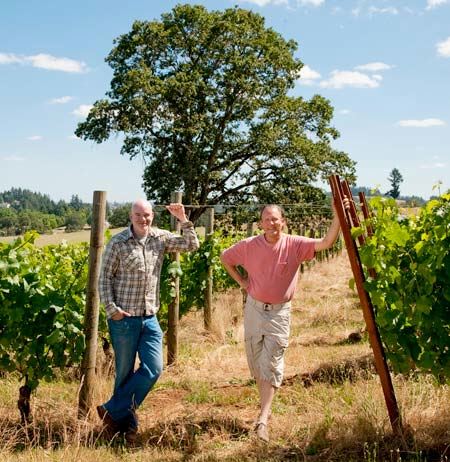
Erin and and Jordan launched their own label, Haden Fig, with the 2007 vintage. Their hip label features a
painting of a Northern Saw-whet Owl, a bird Jordan became enamored with while working at the Portland
Audobon Society as a volunteer veterinarian. The name, “Haden Fig,” requires some explanation and I refer
you to the PinotFile Winery Directory for that information. The Haden Fig wines are from purchased fruit, are
very user-friendly, and sensibly priced. Haden Fig wines are sold on the website (www.hadenfig.com) and
through a mailing list.
Evesham Wood is open to visitors for tasting by appointment (503-371-8478). The wines are in wide retail
distribution. Current production is 5,500 cases (Pinot Noir and Chardonnay are about half estate fruit; smaller
amounts of red and white varietals are offered). Visit the website at www.eveshamwood.com.
I tasted briefly several Haden Fig and Evesham Wood wines at the winery with Erin.

2010 Evesham Wood Temperance Hill Vineyard Eola-Amity Hills Pinot Noir
13.0% alc., 100
cases, $30. Release November 2012. Retro label. From a block planted in 1982. Aged in neutral
barrels.
·
Medium reddish-purple color in the glass. Lovely nose, smelling of a field replete with spring
flowers, and a medley of well-spiced stone fruits. Luscious core of dark red cherries with subtle
cedary oak flavors folded in nicely. A special wine that is quite approachable now. Very good (+).
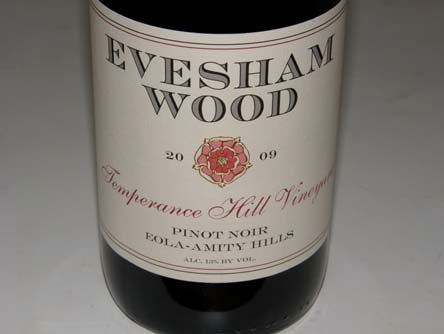
2010 Evesham Wood Mahonia Vineyard Willamette Valley Pinot Noir
13.2% alc., 100 cases, $30. Retro
Evesham Wood label. Old vines planted on volcanic soil. Aged in 20% new French oak.
·
Moderately deep
reddish-purple color in the glass. Very unique nose offering aromas of black stone fruits, spice and violets.
Slightly muscular, with forceful tannins still dominating the fruit. Needs several years in the cellar. Good.
2010 Evesham Wood Ilahe Vineyard Willamette Valley Pinot Noir
13.5% alc., 150 cases, $30. Release
November 2012. A single vineyard barrel selection produced since 2007. Primarily Pommard clone.
·
Moderately rich array of darker berry fruit with an earthy undertone. Chewy, with firm tannins, and quite
restrained at this stage. Good.
2009 Evesham Wood Cuvée “J” Eola-Amity Hills Pinot Noir
$44. Release November 2012. A reserve
barrel selection from Le Puits Sec Vineyard. Primarily estate fruit. Aged in 40% new French oak.
·
The
additional oak adds more structure to this wine which is nicely fruited with exotic spice accents. Smooth on the
palate with an extraordinarily long finish. This beauty will be the showpiece of a special dinner after a few
years in the cellar. Very good.

2010 Evesham Wood Le Puits Sec Eola-Amity Hills Pinot Noir
13.5% alc., 500 cases, $36.
Release September 2012.
·
One of the truly great Pinot Noirs of Oregon and a ridiculous value. At
this year’s IPNC, I was tasting this wine alongside wine critic Josh Raynolds, and as we sampled the
wine, we just looked at each other and shook our head. The epitome of Pinot Noir, with all the
elegance and class that you want from this grape, packing plenty of depth of flavor that only old vines
can give, and ending with a magnificent finish. Very good (+). If you buy only one Pinot Noir from
Oregon’s 2010 vintage, this would be a good choice.
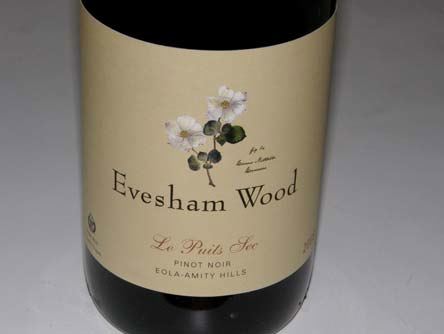
Additional wines: 2010 Eola-Amity Hills Pinot Noir (8 barrels from Erin’s Hidden Rock Vineyard and 8 barrels
from Eola Springs Vineyard which is adjacent Le Puits Sec, $26), 2010 La Grive Bleue Pinot Noir (younger
vines in Le Puits Sec Vineyard, $28), 2011 Willamette Valley (September release, $18), Le Puts Sec
(September release, $36), and 2008 Cuvée Bélier Pinot Noir (one barrel of Le Puits Sec bottled separately,
24-year-old vines, 24 cases, $60). Bruno Willamette Valley Pinot Noir is an inexpensive bottling made by
Evesham Wood and is only available in Oregon.
Et Fille: In The Pink
Howard Mozeico and his daughter, Jessica. (Et Fille translates to “And Daughter” in French) craft small lots of
distinctive Willamette Valley Pinot Noirs from several prime vineyards including the well-known Maresh
Vineyard. The 1,500 case annual production is vinified at August Cellars, a modern gravity flow winery that
houses eight separately bonded wineries that share space and equipment.
I have followed the young winery since the 2005 vintage and have been consistently pleased with the wines. I
visited Jessica at August Cellars and tasted some interesting wines with her from the 2010 vintage.
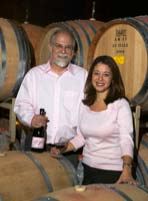
2010 Et Fille Deux Vert Vineyard Yamhill-Carlton District Viognier
200 cases, $24. This vineyard is
located at a warmer site near Lenné Estate and has been a vineyard-designate for Et Fille since 2005.
·
Typical
varietal aromas of tropical fruits including ripe pineapple with a nutty, almond note. Satiny on the palate with
flavors of tropical citrus and honey, backed by a good cut of acidity. Good.

2010 Et Fille Heredity Willamette Valley Pinot Noir
13.1% alc., 176 cases, $34. A reserve blend
from four Willamette Valley vineyards. Aged 10 months in 25% new French oak.
·
Moderate reddishpurple
color in the glass. Aromas of black raspberries, black cherries, strawberries and oak. Soft
and smooth and moderately rich, with shy fruit expression, offering a citrus-peel and oak imbued
finish. Tasted 30 minutes later, the oak had become more integrated and the fruit had moved more to
the forefront. Needs decanting or time. Good (+).
2010 Et Fille Palmer Creek Vineyard Eola-Amity Hills Pinot Noir
13.3% alc., 175 cases, $42. The owners
live on the site and meticulously farm this vineyard.
·
Moderately deep reddish-purple color in the glass. Bright
and persistent aromas of fresh black raspberries, cherries, spice and vanilla cream. Wow! Juicy and crisp with
flavors echoing the nose. Appealing roundness with supple tannins, bright acidity, and a fruit-driven finish that
is soft and long. Impressive balance. Best wine ever from this vineyard for Et Fille. Very good (+).
2007 Et Fille Maresh Vineyard Jim’s Block Dundee Hills Pinot Noir
12.7% alc., 101 cases +, $48. There is
a great story behind this wine that you should read (www.etfille.com/wines/07jims.html). A one-time tribute to
Maresh Vineyard. Sourced from a 1971 planting by Jim Maresh (Block 1) of Wädenswil. Aged 9 months in
50% new French oak.
·
Moderately light reddish-purple color in the glass. Delicate, but pleasing aromas of red
cherries and berries, dried rose petals and sandalwood. Light and graceful on the palate, with savory red fruit
flavors and a hint of complimentary oak. A relatively austere wine styled in the Burgundian tradition.
Very good.

J.Christopher Wines: Pinot in Rhythm
Jay Somers began as a master brewer at McMenamins pub in Portland, apprenticed as a winemaker with John
Paul at Cameron Winery, and then launched his own label in 1996, J. Christopher Wines, specializing in Pinot
Noir, Chardonnay and Sauvignon Blanc. He later formed a partnership with Dr. Ernst Loosen of Dr. Loosen
and J.L. Wolf in Germany called Appassionata (the name of a limited production Pinot Noir that eventually will
be sourced primarily or exclusively from estate fruit). A modern winery was built on Chehalem Mountain at the
same time as the first blocks of Appassionata Vineyard were planted on the estate. A total of 23 acres of Pinot
Noir and Sauvignon Blanc are being established in stages. The vines will be dry farmed after they are
established, and all viticulture is biodynamic. The first estate wines will be released with the 2012 vintage.
I visited the winery on a day that Jay was unavailable. The facility is quite impressive but the tasting
experience was not flattering. A few bottles were set up on a barrel in one of the barrel aging rooms with a
spittoon nearby, but no place to sit or write. I did the best I could. I can tell you that I have enjoyed the few J.
Christopher Pinot Noirs I have tasted in the past, prompting my desire to visit. The style is appealingly
restrained and very food-friendly. The three Terroir Series wines offer a chance to compare AVA terroir and are
very good wines for the price. I did not get to taste the current release of Appassionata Pinot Noir sourced
from Bella Vida and Abbey Ridge vineyards ($75).
All the Pinot Noirs from the 2010 vintage are about 13% alcohol. Approximately 8,000 cases were produced in
this vintage, below the usual production of 11,000 cases annually. Tasting is by appointment (503-554-9572).
Visit the website at www.jchristopherwines.com.
2010 J. Christopher Willamette Valley Pinot Noir
2,100 cases, $26. Sourced from four Willamette Valley
AVAs. Native yeast fermentations and up to 18 months in barrel.
·
Fresh, light, and easy to drink, featuring red
fruits with an herbal undertone. Supple tannins and lively acidity. Decent.
2010 J. Christopher “Nuages” Chehalem Mountains Terroir Series Pinot Noir
335 cases, $35.
A tribute to Django Rheinhart’s “Nuages,” one of Jay’s favorite gypsy jazz tunes. Sourced from
Adams, Lia’s and Olenik vineyards located nearby in the Chehalem Mountains.
·
Light reddish-purple
color in the glass. Impressive thrust of mountain raspberry flavor caressed by mild, grippy tannins.
A delicious wine with vibrant fruitiness that finishes on a refreshing, acid-driven note. Very good.

2011 J. Christopher Croft Vineyard Uber Sauvignon Willamette Valley Sauvignon Blanc
13.0%
alc., $35. Aged in Acacia wood for 8 months.
·
An interesting offering that is less grassy than the
regular Croft Vineyard bottling, offering a pleasing fullness and interesting tannin interplay, finishing
with a bracing cut of lemon-driven acidity. I thoroughly enjoyed this wine and bought a bottle to play
with at home. Very good.
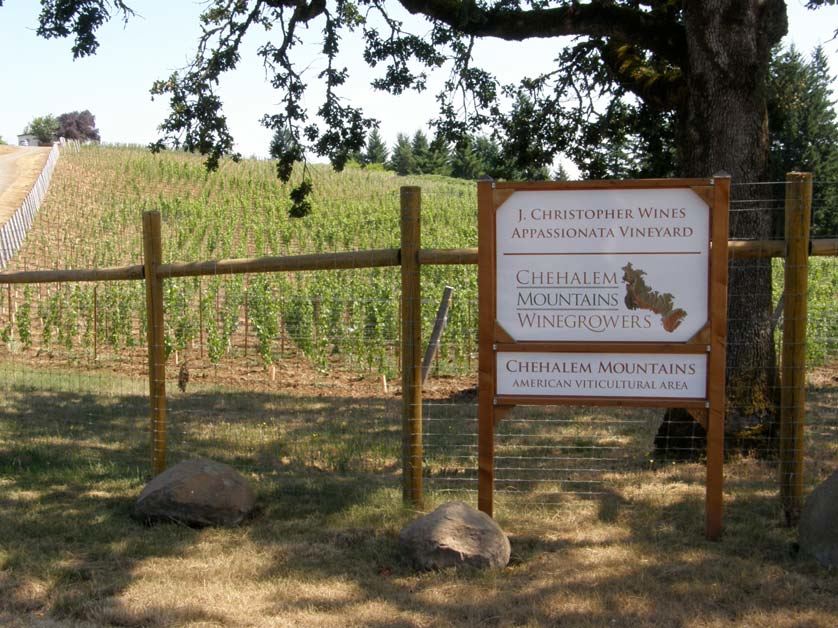
Anam Cara Cellars: Where’s Mark?
The words, “Anam Cara” are Celtic for “friend of my soul,” and speaks to the lasting friendships that develop
over time. Once you visit and meet Sheila and Nick Nicholas, you will develop a deep friendship, for these
winegrowers are very sociable, genuine people. Their 34-acre vineyard, which was originally an overgrown nut
and plum orchard, has soils that are primarily wind-blown ice age sediments over a bedrock of volcanic Jory.
Boulders and rocks scattered across the vineyard were deposited by the Missoula floods, many now covered
with Laurelwood and Yamhill soils of varying depths. The original 28 acres were planted in 2001, with five
blocks of Pinot Noir including Pommard and Dijon clones 114, 115, 667 and 777. An acre each of Riesling and
Gewürztraminer were added, and in 2008, an additional 6 acres were planted to equal blocks of Riesling,
Chardonnay and Wädenswil clone Pinot Noir.
All wines produced are Oregon Certified Sustainable and 100% estate fruit. The new winemaker is Michael
Collier, who finished the 2009 vintage wines and vinified the 2010 vintage wines. Collier was an assistant
winemaker to the former Anam Cara winemaker, Aron Hess, at 12th and Maple Wine Company.
I tasted the 2010 vintage Pinot Noirs, all of which are impressive wines that offer depth and high-voltage
concentration of flavors at lower alcohol levels. Only the 2010 Vineyard Selection Pinot Noir has been
released; the remainder of the wines are scheduled for a fall 2012 release, except the Mark V which will be
released in mid 2013.
The limited production 2010 Estate Chardonnay was released on August 25, 2012. I have never been
particularly enamored with most Oregon Chardonnays even though the potential for this grape in Oregon would
seem boundless. This offering is easily one of the best I have ever had from Oregon.
Visit the website at www.anamcaracellars to join the mailing list and be notified when these wines are released.
Tasting is by appointment or visit the tasting room in downtown Newberg.
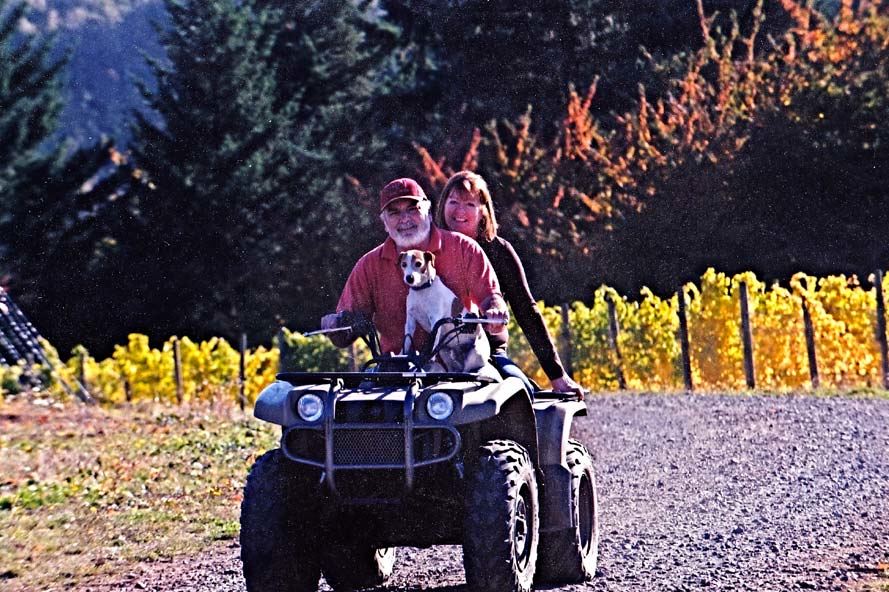
2010 Anam Cara Vineyard Selection Chehalem Mountains Pinot Noir
13.0% alc., 450 cases, $24, screw
cap. Primarily a restaurant by-the-glass program wine. Aged in once-filled and neutral oak. Predominantly
Dijon 114.
·
Light reddish color in the glass. Pleasant perfume of red berries, wild strawberries and spice. Soft,
smooth and elegant, with a lighter-weighted core of red fruits accented with notes of herbs and tar. Decent.
2010 Anam Cara Nicholas Estate Chehalem Mountains Pinot Noir
13.2% alc., 1,200 cases, $32. The
flagship wine, reflecting all five blocks of the vineyard Pinot Noir. Aged in 23% new French oak. A mix of Dijon
and Pommard clones.
·
Light red color in the glass. Very fragrant, plush with bright aromas of fresh berries and
red plums. A pretty wine that exudes finesse, offering tasty raspberry and marionberry flavors, framed by
gossamer tannins, finishing with a tasty raspberry display. Very good.
2010 Anam Cara Reserve Chehalem Mountains Pinot Noir
13.4% alc., 195 cases, $45. 10 rows in each
block are set aside as Reserve potential and maintain a yield of not more than 1.5 tons per acre. The final
blend is chosen by barrel selection. Dijon clones 777, 115, 114 and Pommard. Aged in 37% new French oak.
·
Light reddish-purple color in the glass. Deeply perfumed with dark red pie cherries, fraise du bois and stem.
Middleweight flavors of dark red berries fan out nicely on the palate, with notes of earth, tar and oak adding
interest. A second pass at the wine was made after pouring through a Venturi. The wine became much more
expressive aromatically with aromas and flavors of fresh-picked berries and savory herbs. Elegant and soft in
the mouth with a plush finish. Not fully forthcoming, but well balanced, and should be terrific after a few years
in the cellar. A commendable expression of the vintage. Very good.
2010 Anam Cara Heather’s Vineyard Chehalem Mountains Pinot Noir
13.4% alc., 50 cases, $65. The
most elegant expression of the vineyard, using the lightest oak treatment (no new oak, 100% once-filled
barrels). 50% Dijon 114, 36% Dijon 777 and 14% Pommard. Usually the wine is from ten rows of Dijon clone
114 in a late ripening block cropped to 1.5 tons per acre. The 2010 bird invasion wiped out these rows which
abutted the tree line. The blending process then opened to include other clones. The wine is named for the
Nicholas’ daughter.
·
Light reddish-purple color in the glass. Very fragrant, like a well-perfumed woman with a
dab of crushed cherries and sandalwood behind her ear. See-through elegance, featuring ripe dark candied
griottes cherries, sweet and seductive in the middle and languorous and slinky at the end. Will pick up intensity
with more time in the bottle. Very good (+).
2010 Anam Cara Mark V Chehalem Mountains Pinot Noir
13.4% alc., 50 cases, $65. Largest percentage
of new oak (50%). 77% 777, 13% Pommard and 10% 667. Crafted to be big and rich choosing the boldest
clones and blend from the Reserve rows and barrels. Named for the Nicholas’ son, the Roman numerals
denote the wine’s place in the series.
·
Deepest reddish-purple color in the lineup. Intensely perfumed with
perfectly ripe dark red berries with a complimentary scent of oak and dark rose petals. The most intense wine
in this vintage and the wine with the most length. It hits the mid palate with a vengeance, expands in the
mouth, and ends with a voluptuous charge of fruit that satiates the senses for a minute. A very young, but
remarkable wine that is the best ever Mark release from Anam Cara. Grab a few bottles for your cellar; you will
thank me down the line. Very good (+).
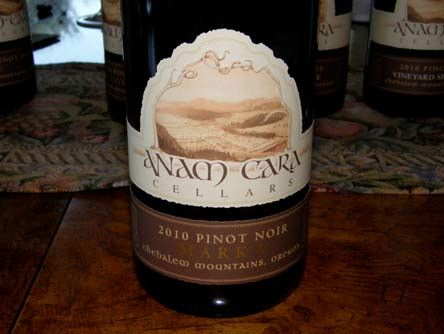
Anne Amie Vineyards: Red and White Pinot Noir
Winemaker Thomas Houseman is a former modern dancer who learned his fermentation making beer in his
New York apartment, went on to learn winemaking at University of California at Fresno, and paid his dues at
wineries in Anderson Valley, New Zealand and the Willamette Valley before becoming the Director of
Winemaking at Anne Amie. Anne Amie had struggled since its founding in 1999, but it was clear that the
owner, Robert Pamplin, Jr., had the resources to succeed. The hiring of Thomas quickly transformed Anne
Amie and positioned the winery in the upper echelon of Oregon wine producers. Thomas can be loose, a bit
crazy, and more enthusiastic than anyone deserves to be, but he knows how to make great wine (with a grin).
Anne Amie Vineyards provides Thomas with a widely varied estate vineyard palate to work with and gives him
a long reign to succeed. Anne Amie also has access to grapes from several prominent vineyards in the
Willamette Valley, adding to the possibilities.
Anne Amie Vineyards is located at 6580 NE Mineral Springs Road in Carlton. The tasting room has a pleasant
outdoor patio with view of the estate and surrounding vineyards in the Yamhill-Carlton AVA. The winery
specializes in Pinot Noir, but offers a number of other white varietals. Prismé, the winery’s Pinot Noir Blanc, is
one of the best examples produced in Oregon (see article on Pinot Noir Blanc in this issue).
I had a seated tasting with Thomas at Annie Amie and amongst the ribald talk and laughing, I tasted some
wine. (Thomas is pictured above to my right at this year’s World of Pinot Noir).
Thomas says the 2010 vintage wines “are my favorite wines I have ever made. He has committed to screw
cap closure in nearly all the Annie Amie wines beginning with the 2010 vintage which will be released over the
latter months of 2012 and early 2013. Visit the website at www.anneamie.com for availability of the wines.
2010 Annie Amie Willamette Valley Pinot Noir
12.9% alc., pH 3.57, TA 0.62, 1,971 cases, $35. Release February 2013. Anne Amie Estate, Twelve Oaks Estate, Rainbow Ridge and Alloro vineyards. 7-20 day cold soak, extended maceration, on skins 28-49 days. Aged on lees in 15% new, 34% 1-year, and 51% neutral French oak barrels for 16 months. Aged in bottle for 12 months before release.
·
Raspberry color in the glass. Nicely scented
with aromas of fresh raspberry coulis and spice. Moderately rich with flavors of sweet red plums and dark
raspberries, with the fruit pulled into line with good acidity and fine tannins. A very impressive Willamette Valley
bottling that can perform beautifully as a daily drinker. I recommend it for case buys. Very good.
2010 Anne Amie Twelve Oaks Estate Chehalem Mountains Pinot Noir
13.3% alc., pH 3.57, TA 0.63, 124 cases, $50. 100% Twelve Oaks Estate Vineyard in the Chehalem Mountains. 5-day cold soak, 10-day fermentation. Aged 16 months in 40% new, 20% 1-year and 40% neutral French oak barrels. Bottled unfined and unfiltered and bottle aged for 12 months before release.
·
Moderately light
reddish-purple color in the glass. The aromas leap out of the glass with effusive notes of fresh berries, roses
and spice. Deep, dark red berry, strawberry nectar reduction, and brown spice flavors with well proportioned
acidity and tannins, finishing with a sappy cherry highlight. Very good (+).
2010 Anne Amie Estate Vineyard Yamhill-Carlton Pinot Noir
13.4% alc., pH 3.58, TA 0.59, 124 cases, $50. Release May 2013. 100% estate vineyard grapes. Pommard and Dijon 115 clones
grown on Willakenzie soils. Aged 16 months in 60% new, 20% 1-year and 20% neutral French oak barrels. Bottled unfined and unfiltered and bottle aged for 12 months before release.
·
Medium reddish-purple color in the glass. Vibrant aromas of fresh dark cherries
and berries complimented with exotic spices. A serious wine with structural power, featuring sappy dark plum
and blackberry flavors, backed by frisky acidity and fine-grain tannins, finishing with poise and richness. Still a
Lolita. Very good (+).
2009 Anne Amie L’Iris Willamette Valley Pinot Noir
14.1% alc., 260 cases, pH 3.63, TA 0.56, $75. Release
May 2013. A barrel selection sourced from several vineyards including Anne Amie Estate and Twelve Oaks
Estate. Pommard, 777, 115 and 828 clones. 100% de-stemmed. Aged 18 months in 20% new, 40% 1-year,
and 40% neutral French oak. Unfined and unfiltered.
·
Moderately deep reddish-purple color in the glass. A
wine with serious intentions and longevity. Bright aromas of berry mash with baking spices and clove.
Moderately rich core of black cherry, berry and plum fruit flavors with an earthy, tea accent. Powerfully
structured so will need time for the tannins to soften. Impressive. Very good.
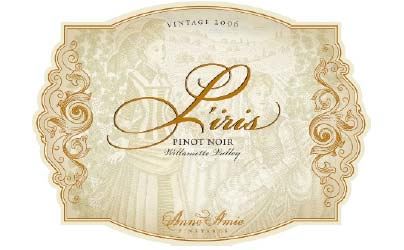
2009 Anne Amie Prismé Yamhill-Carlton Pinot Noir Blanc
14.1% alc., 404 cases, $45, screw cap. Sourced
from Anne Amie Estate and Rainbow Ridge vineyards. Barrel fermented, full MOF, and aged on lees for 18
months. Previously reviewed May 11, 2012.
·
Aromas of white stone fruits, biscuit, crème brulée, and roasted
nuts. Delicious and full on the palate with slight viscosity, offering flavors of baked pears, white peaches, and
brown butter. A highly enjoyable, unique wine that challenges the preconceived sense of Pinot Noir. Oregon’s
finest Pinot Noir blanc. Very good (+).
2011 Anne Amie Cuvée A Pinot Noir barrel sample 12.9% alc.. Multiple vineyards, soils and clones. 10-15%
whole cluster. Aged 10 months in 20.3% new French oak barrels. The winery’s entry level Pinot Noir. More
structured than the 2010 offering with the same weight of sweet, red and blue fruits. Always a reliable wine.
Decent.
2011 Anne Amie Willamette Valley Pinot Noir barrel sample More power than the 2010 version, but
otherwise very similar, with good depth at low alcohol. Solid.
2011 Anne Amie L’Iris Willamette Valley Pinot Noir barrel sample Deep color with striking fruit
concentration and density backed by great acidity. Will spend another year in bottle. Terrific.
2011 Anne Amie Twelve Oaks Vineyard Chehalem Mountains Pinot Noir barrel sample Very promising
with great fruit purity and very refined tannins. Solid.
2011 Anne Amie Estate Vineyard Yamhill-Carlton Pinot Noir barrel sample Impressive fruit density and hitone
aromatics backed by very fine-grain tannins. Outstanding.
2010 Technique vs Terroir: The Cube Experiment Three wines crafted by Thomas Houseman at Anne
Amie. See seminar at this year’s World of Pinot Noir (www.princeofpinot.com/article/1195/). A presentation of
The Cube Experiment was also offered at this year’s International Pinot Noir Celebration. Three wines from
Pommard clone, one from Annie Amie estate Willamette Valley vineyard, one from Bouchaine estate Carneros
vineyard and one from Lincourt Sta. Rita Hills estate vineyard, all vinified identically by Thomas. When the
wines are tasted from the same vineyard made by three different winemakers, the winemakers hand stands
out, but if one tastes the three different regional wines made by the same winemaker, the regions stand out (I
was able to guess blind one of the regions but was unsure about the other two, mistakenly switching them, but
after I was told the correct regions, I could concur). These wines will be available for purchase so one can
taste the wines in a similar blind fashion, looking for winemaker style and/or regional (terroir) character (inquire
at the winery).
White Rose Estate Winery & Vineyard: Got Whole Cluster?
In 2000, successful businessperson Greg Sanders bought the storied 10-acre White Rose Vineyard located in
a prime southeast-facing slope in the Dundee Hills AVA of Yamhill County. The vineyard was planted in 1980 to
own-rooted Pommard clone at an elevation of 870 feet on deep Jory soil. Situated just west of Domaine
Drouhin Oregon and east of Domaine Serene, this vineyard commands a striking view of the Willamette Valley
and the hilltop location contributes to a long hang time.
Greg had his ups and downs early on, but he has persevered, and his wines are now among the most
distinctive in the Willamette Valley. Greg began producing Pinot Noir in 2001 and after seven vintages as
winemaker, he settled into a consulting role and appointed Jesus Guillen the winemaker in 2008. Jesus has
managed the day-to-day winemaking procedures since 2002 (Greg lives in Southern California where his
manufacturing business is located). A giant leap in quality arrived with the 2008 vintage, when the Wine
Advocate gave the wines very high scores and two of the White Rose wines were PinotFile All-Americans. As I
noted, “Sander’s dreams of Grand Cru quality wines from Oregon have been realized.”
In 2009, Greg acquired an additional 4 acres of vineyard immediately north of the original site (Guillen
Vineyard). Planted in 2001 to Dijon clone 115 grafted onto American rootstock, this site is showing
considerable potential. Fruit is also purchased from a number of growers in the Yamhill-Carlton District AVA,
Dundee Hills AVA, and Chehalem Mountains AVA. Greg visits the vineyards personally, selecting the best rows
for his appellation cuvées.
Greg believes in grooming his vines with a higher canopy, believing this leads to slower maturation and longer
hang time. Most wineries hedge their vines at about a 5 to 6 foot level. The photo below shows not only the
high canopy, but the deep reddish-brown soil typical of the Dundee Hills.
I spent some time with Greg on my visit in July, and I came away impressed by his winemaking operation, his
intuitiveness, and his meticulous approach. He uses a very high percentage of whole cluster fermentation
(40%-100%). His reasoning is that this approach allows the wines to be drinkable early on, but holds back the
fruit to fully emerge and improve later as the wine ages. It is a style that offers the best of New World (early
drink ability) and Old World (age ability) Pinot Noir.
Greg’s team hand carries buckets of just-picked grapes at harvest directly to the fermentation vats located in
the winery on the property. Every step thereafter is intended to avoid seed tannins which can be harsh and
take years to resolve. He uses an old-fashioned hand crank basket press so he can carefully control pressure,
preserving some liquid around the seeds without crushing them before they are discarded. Pump overs are
used to disseminate the cap, and the wines are barrel fermented and aged in a low percentage of new oak
(10%).
The 2010 White Rose wines have not been released and I will review them later this year. I did taste two 2009
Pinot Noirs at the tasting bar. To guarantee an allocation of the coveted 2010 wines, join the Explorer’s or
Collector’s Wine Club (www.whiterosewines.com). The wines are not inexpensive, but then Pinot Noir at its
epitome never is. The tasting room is open daily from 11:00 to 5:00. Tours by appointment (503-864-2328).
Greg treated me to a taste of 2011 Pinot Noirs from White Rose Vineyard and Luciole Vineyard; the White
Rose Estate Pinot Noir was stunning and I could still taste it the next day.
2009 White Rose Estate White Rose Vineyard Dundee Hills Pinot Noir
13.8% alc., $70. Select barrels of
the four oldest blocks in the estate vineyard. 60% whole cluster.
·
Moderately light reddish-purple color in the
glass. Shy, but pleasing aromas of dark raspberries, spice and clove. Middle weight flavors of juicy
raspberries and cherries with a note of seasoned oak, spice and a hint of good stem. Supportive, ripe tannins
and impressive persistence and intensity on the generous finish. A delicious wine that is very outgoing now,
but will stay the course for many years. Very good (+).
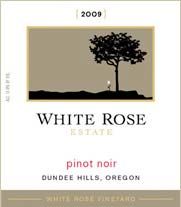
2009 White Rose Estate White Rose Vineyard “Guillen” Dundee Hills Pinot Noir
13.9% alc., $60.
Produced from Block 5 of White Rose Vineyard, Dijon 115 clone planted in 2001.
·
Light reddish-purple color in
the glass. Shy aromatics with delicate aromas of black and blue berries, spice and briar. Mid weight flavors of
red and black raspberries with an earthy undertone and a finishing kick of spice and toasty oak. Well-mannered
with fine tannins and juicy acidity. Good.